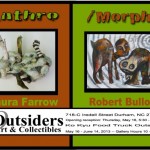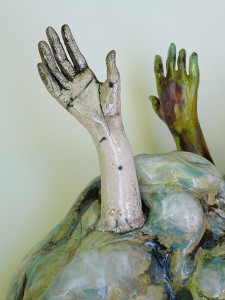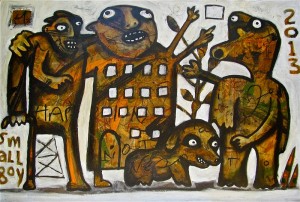 The Work of Laura Farrow & Robert Bullock
The Work of Laura Farrow & Robert Bullock
Artists Reception
Thursday May 16
5:30-8:00 PM
On The Street: Ko Kyu Food Truck
Exploring the work of two artists; one trained, one self-taught but both who have in common the use of animal imagery with human characteristics and produce work seemingly from an ancient place, influenced by the art and philosophies’ of places like India, Tibet, China, and Thailand.
 Laura was the first of three kids born to a restless Baptist minister and an artistic housewife in the early ’60s. She grew up north and south of the Mason-Dixon Line and split her college years between MICA and Montana State University, earning a BFA in 1984 with painting as her primary medium.
Laura was the first of three kids born to a restless Baptist minister and an artistic housewife in the early ’60s. She grew up north and south of the Mason-Dixon Line and split her college years between MICA and Montana State University, earning a BFA in 1984 with painting as her primary medium.
For the past decade, Laura has worked almost exclusively in clay, carrying her painterly sensibilities with color and form into the third dimension. Currently, she is expanding her focus further to incorporate other media (paper mache, fibers, wire, etc) in her ceramic works, and to create within one object the perfect marriage of 2-dimensional surface painting and sculptural clay.
Laura’s current series explores the conversation between three characters (a rabbit, a figure, and a cloud) that emerged together spontaneously during a stream-of-consciousness studio session last summer. Like interpreting a dream, the characters and the conversations shifted as the series evolved.
Robert Bullock is the founder and director of the Coalition Ingenu Self-Taught Artists’ Collective. Although Bullock was also a self-taught artist with a history of homelessness, he rarely included his work in exhibits with the Collective throughout the first 15 years of its existence.
 As CISTAC evolved further away from the social service organization that had begun by conducting open studios at homeless shelters and hospitals, and as Bullock retired from painting murals with the Philadelphia Mural Arts Program, he began allowing increasingly more time for his own artistic experiments. At first, he sought to distance himself from his role as director of the nonprofit and began signing his work simply with the nicknames of “Small Boy” or “Bullick”. He was hoping, by so doing, that he could treat himself like any other artist and promote his work the way he had for so many other artists and members of the CI Collective. He soon realized, however, that it would ultimately become impossible to pretend that he and “Small Boy” were not one and the same person. Still, the nickname seemed to fit, especially since Bullock felt as though the imagery that was turning up more frequently in his work was coming from a return to the sensitivity that he remembered as a small boy.
As CISTAC evolved further away from the social service organization that had begun by conducting open studios at homeless shelters and hospitals, and as Bullock retired from painting murals with the Philadelphia Mural Arts Program, he began allowing increasingly more time for his own artistic experiments. At first, he sought to distance himself from his role as director of the nonprofit and began signing his work simply with the nicknames of “Small Boy” or “Bullick”. He was hoping, by so doing, that he could treat himself like any other artist and promote his work the way he had for so many other artists and members of the CI Collective. He soon realized, however, that it would ultimately become impossible to pretend that he and “Small Boy” were not one and the same person. Still, the nickname seemed to fit, especially since Bullock felt as though the imagery that was turning up more frequently in his work was coming from a return to the sensitivity that he remembered as a small boy.
His work was a conscious effort to stop fighting the emotions that had once overwhelmed him, and embrace the sentimental and dramatic perceptions that had made his youth so troubling. Robert’s early schoolteachers had often referred to “Bobby” as a very “distracted” child living in “a world of his own.” A painful shyness made his early teens very awkward until he taught himself how to play the drums and joined a rock group. Music made him popular and sustained him in many ways throughout the next few decades, toward the end of which he toured with a band throughout the West and Midwest of the U.S. Bullock also worked a series of odd jobs and traveled quite a bit between each one, mostly in the style of the old time hobos – hitching from place to place – finding a little work where he could. Some of these trips would last more than a year. It was during one such trip –- a two-year soul searching trek throughout Australia, New Zealand, Papua New Guinea, Indonesia, Thailand, and the Philippines – that Bullock determined that visual art was his passion and his calling